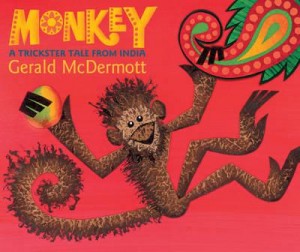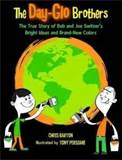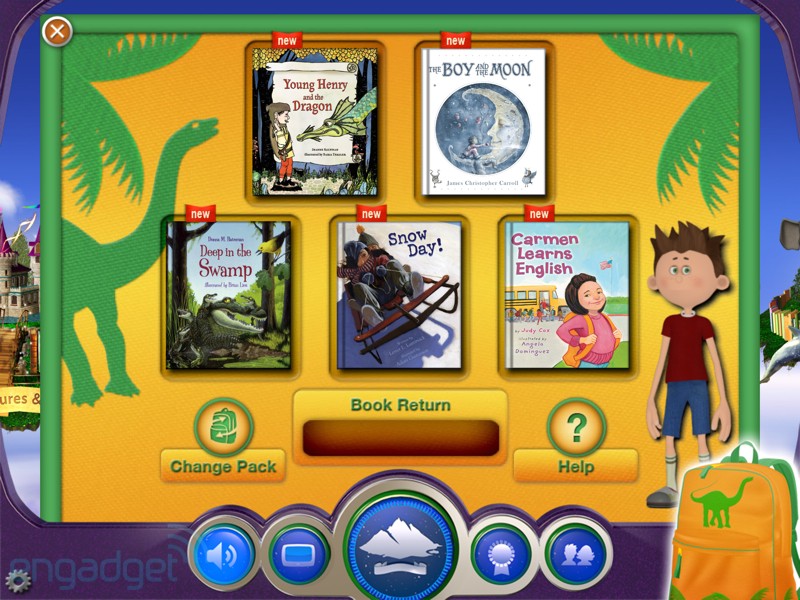Doggone Feet is Doggone Fun!
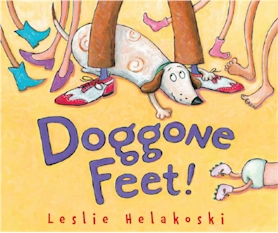 There are many perks to being a children’s librarian (no overdue fines has saved me a bundle over the years) but one of the best parts of my job is getting to know supah-cool authors and illustrators like Leslie Helakoski. Leslie is a Michigan treasure I’ve had the pleasure of knowing for years, and I’m geeked to share her brand new book with you: Doggone Feet.
There are many perks to being a children’s librarian (no overdue fines has saved me a bundle over the years) but one of the best parts of my job is getting to know supah-cool authors and illustrators like Leslie Helakoski. Leslie is a Michigan treasure I’ve had the pleasure of knowing for years, and I’m geeked to share her brand new book with you: Doggone Feet.
Dog follows a pair of feet home from the park one day and finds her perfect place under the table. Life is good until two more feet come on the scene:
“They’re twirling leg twisters, toe-tapping kiss-kissers,
rule-listing insisters of doggy shampoos.”
So now the space under the table includes the dog and two sets of two feet, until another pair come along – tiny baby feet. As the family grows the dog must accommodate more pairs of feet in her shrinking space, and she’s not sure she likes the new additions. In the end, though the space under the table is crowded and cramped, the message is clear: families always make room for more.
The first time I read this book, I immediately thought how it perfect it would be for a math lesson. If there were two dogs and three humans, how many feet would be under the table? It’s also a great book to talk about point of view – both figuratively and literally. The story is told from the dog’s perspective, and we don’t see the faces of the humans, just their feet, until the end of the book. You can talk with your students about author/illustrator’s Craft and Structure – why did Ms. Helakoski choose to frame all the illustrations from this different point of view? How might a mouse see life under a dinner table, or a fly over a school cafeteria table at lunchtime? It’d be fun to have students spend a writing session on the floor under their desks, to inspire them to write and draw from a different point of view.
Then I saw the terrific trailer that Leslie’s son, Connor, made for her book:
How cool would it be to combine book-trailer technology with a math lesson centered around Doggone Feet?! Using a free app like Educreations on the iPad or a program like iMovie on computers, students could make a mini-movie to retell the events of the story (check off Key Ideas and Details on your Common Core State Standards score card) either by drawing the action or physically acting it out, adding up the feet as you go. With all the wonderful rhyme and wordplay, it’d be great for Reader’s Theater! Doggone Feet will be so doggone much fun for your students!
For more information, please visit Leslie’s website at helakoskibooks.com.
Read MoreTwo Perfect “Picks” for Valentine’s Day: Porcupining and Hokey Pokey
This Valentine’s Day, I’d like to share with the readers I love (you!) some of the things I love: wonderful pun-packed picture books by my author-crush Lisa Wheeler and free, already-planned activities to make teaching those books super-easy.
Porcupining: a Prickly Love Story and Hokey Pokey: Another Prickly Love Story, both written by Lisa Wheeler and illustrated by Janie Bynum, feature one of my most-beloved picture book characters, Cushion the Porcupine. We first meet Cushion in Porcupining where he is looking for love in all the wrong places. This forlorn hero of the petting zoo finally finds true love with Barb, a hedgehog. Then, in Hokey Pokey, Cushion wants to make his beloved Barb happy by learning to dance. Asking a fox, a rabbit, and a chicken for dance lessons only leads to prickly situations, and once again Cushion seems stuck out of luck. But Barb proves to be the perfect pick for Cushion when she teaches him all the moves he needs, and together they dance the Hokey Pokey.
 Comparing and contrasting two stories with the same characters, same author, and/or same illustrator is a great way to teach the Common Core State Standard of Integrating Knowledge and Ideas. On her website lisawheelerbooks.com, Lisa has a free teacher’s guide to go with these books. Use the graphic organizer from the teacher guide for Porcupining (written by super-cool author Tracie Vaughn Zimmer) to compare the main character, the problem, the three ways the character tries to solve the problem, and the solution in both books. Then, print off the adorable recipe cards for Cushion Cookies (made by another super-cool author Hope Vestergaard) and your Valentine’s Day is set!
Comparing and contrasting two stories with the same characters, same author, and/or same illustrator is a great way to teach the Common Core State Standard of Integrating Knowledge and Ideas. On her website lisawheelerbooks.com, Lisa has a free teacher’s guide to go with these books. Use the graphic organizer from the teacher guide for Porcupining (written by super-cool author Tracie Vaughn Zimmer) to compare the main character, the problem, the three ways the character tries to solve the problem, and the solution in both books. Then, print off the adorable recipe cards for Cushion Cookies (made by another super-cool author Hope Vestergaard) and your Valentine’s Day is set!
My Book!
 Every week, I write about a terrific picture book to read aloud to students along with a lesson plan or an extension activity. I am jump-up-and-down, wave-my-arms-like-Kermit-the-Frog excited to finally be able to write about my picture book!
Every week, I write about a terrific picture book to read aloud to students along with a lesson plan or an extension activity. I am jump-up-and-down, wave-my-arms-like-Kermit-the-Frog excited to finally be able to write about my picture book!
The title is To See Or Not To See. It’s the story of Groundhog and his dilemma on February 2nd. Half of his friends want him to see his shadow so that winter will last six more weeks. Half of his friends don’t want him to see his shadow so that spring will come early. What will Groundhog do? You’ll find out in the fall of 2015, when the book will be published by Charlesbridge!
Why such a long time to wait, you ask? I know, I wondered about that myself! But in the publishing world, two years is actually quick to make a picture book. My editor and I (my editor! Squeee!) will need to review my manuscript and decide what descriptions can be taken out because the art will show those details. An illustrator has to be chosen for the book – and I don’t get to do the choosing! In publishing, the author rarely has a say as to who will illustrate the book. It’s up to editors and art directors who know the business to match up the right art style with the words. So, an illustrator has to be picked and given time to work on the illustrations. Most illustrators (like my wonderful husband, Matt Faulkner) take months to make the art for a picture book. After that, the art and the words have to be printed together, ink colors made just right, decisions made about font and layout, marketing and promotional decisions have to be made… it’s quite a process!
I’ll be sharing the details here at kristenremenar.com if you’d like to follow along. I’m hoping to hear within a few weeks who my illustrator will be. I’d love it if my husband is chosen – but can’t imagine how I’d handle knowing that the art for my first book is being made up in my husband’s studio without constantly peeking in!
Thanks to all of you who’ve signed up for my newsletter and read my blog. I love sharing my good news with people who love children’s books as much as I do!
P.S. And, as a bit of glorious synchronicity, I got The Call from my editor about the sale of my first book, my Groundhog story, on my birthday, which is Groundhog’s Day. 🙂
Read More“This Is Not My Hat” wins the Caldecott Medal!
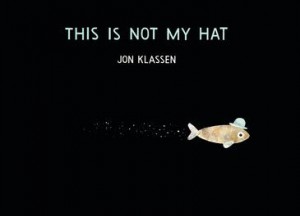 If you’re a kid-lit lover like me, you already know that This Is Not My Hat written and illustrated by Jon Klassen won the Caldecott Medal for 2012. (Were you huddled around your computer screen that morning, too, watching the live broadcast and squealing when your favorites were announced? Just me? Ok.)
If you’re a kid-lit lover like me, you already know that This Is Not My Hat written and illustrated by Jon Klassen won the Caldecott Medal for 2012. (Were you huddled around your computer screen that morning, too, watching the live broadcast and squealing when your favorites were announced? Just me? Ok.)
This Is Not My Hat is an ideal picture book to teach the Common Core Standard of Integrating Knowledge & Ideas: “Use information gained from the illustrations and words in a print or digital text to demonstrate understanding of its characters, setting, or plot” and “explain how specific aspects of a text’s illustrations contribute to what is conveyed by the words in a story (e.g., create mood, emphasize aspects of a character or setting).” The story told by the text is not exactly the same as the story told by the pictures. (Working on a lesson on inference? Grab this book!)
A little fish (the fellow you see on the cover) is narrating the story as he swims. “This hat is not mine,” he admits. He stole it from a big fish, and we see the big fish sleeping. “…(H)e probably won’t wake up for a long time,” says the little fish, and we see the same illustration of that big fish, but now his eyes are wide open. So all the words are from the little fish’s point of view, but we see in the illustrations what the little fish doesn’t realize – the big fish does realize his hat was stolen, does know who took it, and is out to get his hat back. The end shows the big fish with his tiny hat back on his head, and the little fish is nowhere to be seen. Anyone want to infer what happened in the end?
Kids who loved Klassen’s I Want My Hat Back will adore this book, and find similarities beyond the hat theme. So share This Is Not My Hat and compare the information gained from the illustrations to the information we get from the text, and then compare the two books, and you’ll have a double-whammy Integration of Knowledge & Ideas lesson! The endings for both books is left up to the reader to figure out. You can have students debate what they think happens at the end, and give reasons to support their position. Do any of your students think the little fish got away? If he did, what might happen next?
Because there are only three characters in This Is Not My Hat (little fish, big fish, and tattle-tale crab) it’s super-easy to make a Storybox with the book and either stuffed animals, puppets, or felt pieces of the characters for kids to retell the story. If you’re crafty, have kids make hats from brown paper bags (keeping with Klassen’s muted tones) for them to swap and declare, “This is not my hat!”
Read MoreLet’s Talk About Race
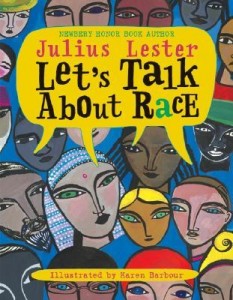 “It is time for parents to teach young people early on that in diversity there is beauty and there is strength.” – Maya Angelou.
“It is time for parents to teach young people early on that in diversity there is beauty and there is strength.” – Maya Angelou.
Next Monday we celebrate the birthday of the Reverend Dr. Martin Luther King, Jr. What better way to honor his dream of a nation where our children “will not be judged by the color of their skin but by the content of their character” than with a wonderful children’s book celebrating our differences and our similarities.
Let’s Talk About Race is written by Julius Lester and illustrated by Karen Barbour. “I am a story,” Lester writes. “So are you. So is everyone.” Our race is just one part of our stories. “To know my story, you have to put together everything I am.”
How does your story begin? When were you born, and who is in your family? What is your favorite food, your religion, your favorite color, your nationality? All of these things are a part of our stories. But, “some stories are true. Some are not. Those who say ‘MY RACE IS BETTER THAN YOUR RACE’ are telling a story that is not true.”
Lester goes on to tell a story that is true: if you press your fingers gently below your eyes, you can feel the bone beneath your skin. And if you press gently on a friend’s face, no matter what their skin color, you will feel the bone there, too. “Beneath our skin I look like you and you look like me…” Instead of focusing on the stories we can make up about each other based on eye color, skin color, and hair texture, we can find out the true stories, the rich and complex stories, of each other.
After you read Let’s Talk About Race with your students, talk about race! And talk about all the other wonderful parts of our stories, from favorite foods to hair color to pet peeves. You can make a questionnaire based on all the elements Lester talks about for students to answer. Next, challenge students to find someone else who had the something the same on his or her list. You can integrate this into a math lesson by graphing some of the answers, like eye color, or get out the art supplies and let students make cool representations of themselves. If your students can “identify the main purpose of a text, including what the author wants to answer, explain, or describe”, you’ll hit the Common Core State Standard of Craft and Structure using a book with a truly worthwhile main purpose.
Read MoreMonkey: a trickster tale from India
It’s January, and is it just me, or are your kids more wiggly than a troop of monkeys, too? Here’s a book to get your kids monkeying around in a good way, and you’ll be teaching the Common Core State Standard of Key Ideas and Details.
Monkey: a trickster tale from India by Gerald McDermott is a beautifully illustrated Indian folk tale. (Reading folktales from different cultures is part of the Key Ideas and Details Standard for Reading Literature.) Monkey wants to get to the island in the middle of the river to eat the mangoes. Crocodile lives in the river and he wants to eat Monkey’s heart. How does Monkey get to the island without being eaten?
Before reading this book, ask your students how you might get across a river where a hungry crocodile lives. Compare, as you read, their suggestions to what Monkey does in the story. Then, teach your “monkeys” cooperative learning and problem-solving skills: give teams of students the same objects like a rope, a scooter, a beach towel, etc., and challenge them to get their entire team across the river (the playground or the gym) without touching the ground or the “water” where the crocodile could get you! To alleviate frustration and encourage learning from errors, if anyone does touch the ground, let the team start over, and brainstorm how to avoid that problem in the next go.
When you return to the classroom, encourage students to experiment with painting paper and cutting it to make cool collages, much like McDermott did for this book. An art activity, cooperative learning that gets kids moving, and a beautiful book – it’s more fun than a barrel of, well, you know!
For more about this Caldecott-winning author/illustrator, please visit geraldmcdermott.com.
Read MoreThe Day-Glo Brothers on a free app – what a bright idea!
I’m a librarian partly because I couldn’t afford my book habit if I had to buy every book I read. So when I’m looking for e-books, I usually look for free ones (some call me cheap, I prefer “fantastically frugal”). But I don’t want crummy books – I want the good stuff! Leave it to Reading Rainbow to hook me up with quality children’s books for free (and a huge variety of even more titles if I want to pay for a subscription).
I downloaded the free Reading Rainbow app to my iPad and was greeted by Levar Burton ( a man who has lured more children to reading than the Pied Piper lured rats, but you don’t have to take *my* word for it.) I was thrilled to find one of my favorite biographies, with complete text and art, a bit of fun animation, and even a game to play.
The Day-Glo Brothers: the true story of Bob and Joe Switzer’s bright ideas and brand-new colors is written by Chris Barton and illustrated by Tony Persiani. Bob and Joe Switzer were in their father’s drugstore when they discovered that certain chemicals glow under ultraviolet light. With lots of experimenting and some accidental luck, the brothers invented colors that would glow even in sunlight, those neon colors called Day-Glo. It’s a “brilliant” story about perseverance, for, as Joe used to say, “If just one experiment out of a thousand succeeds, then you’re ahead of the game.”
So now you can share this enlightening biography (CCSS Range of Reading – check!) with your students for free in paper-book form from the library, or you can share it on iPads with the free Reading Rainbow app. Charlesbridge has a free activity guide to go with the book, along with an author interview and an animation on how fluorescence works. How fun would it be to put a blacklight in a lamp in your classroom and get fluorescent markers for an art project. Students can try making one of the props Joe used in his magic shows, or you can have students demonstrate with Day-Glo colors why we see the phases of the moon. A great biography on a free app – what a bright idea!
Read More





